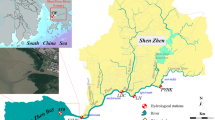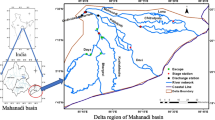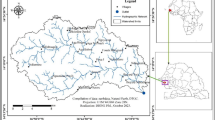Abstract
The development of methods for studying river runoff formation to integrate the up-to-day instruments of point hydrological–hydrochemical observations with new concepts and modern simulation means is discussed. The proposed methodological approaches are mostly based on the results of several years of works in an experimental mountain-forest basin in the southern Far East, Russian Federation. Despite the moderate experience analyzed in the article, the tested methodology is shown to be valuable and effectively applicable to basic hydrological studies and engineering–hydrological surveys, accompanying the designing of large facilities.
Similar content being viewed by others
References
Berseneva, I.A., Klimaty aridnoi zony Azii (Climates of the Arid Zone of Asia), Moscow: Nauka, 2006.
Boldeskul, A.G., Shamov, V.V., Gartsman, B.I., and Kozhevnikova, N.K., Ionic compositioin of genetic types of waters in a small river basin: stationary studies in the Central Sikhote Alin, Tikhookean. Geol., 2014, vol. 33, no. 2, pp. 90–101.
Bugaets, A.N., Gartsman, B.I., Krasnopeev, S.M., and Bugaets, N.D., An experience of updated hydrological network data processing using the CUAHSI HIS ODM data management system, Russ. Meteorol. Gidrol., 2013, no. 5, pp. 359–366.
Vinogradov, V.N. and Kuptsov, A.N., On the hydrology of dry rivers in regions of active volcanism, Vodn. Resur., 1980, no. 5, pp. 178–184.
Vodnye resursy rek zony BAM (River Water Resources in BAM Zone), Chebotarev, A.I. and Dobroumov, B.M., Eds., Leningrad: Gidrometeoizdat, 1977.
Gartsman, B.I., Hydrographic and landscape description of a river basin based on GISand geographic data, Russ. Meteorol. Gidrol., 2014, no. 6, pp. 407–415.
Gartsman, B.I., Shamov, V.V., and Tret’yakov, A.S., A system of water balance models of a small river basin, Geogr. Prir. Resur., 1993, no. 3, pp. 27–36.
Gidrologiya zabolochennykh territorii zony mnogoletnei merzloty Zapadnoi Sibiri (Wetland Hydrology of Permafrost Zone), Novikov, S.M., Ed., St. Petersburg: VVM, 2009.
Gubareva, T.S., Gartsman, B.I., Shamov, V.V., Boldeskul, A.G., and Kozhevnikova, N.K., Genetic disintegration of the runoff hydrograph, Russ. Meteorol. Gidrol., 2015, no. 3, pp. 215–226.
Zhil’tsov, A.S., Gidrologicheskaya rol’ gornykh khvoinoshirokolistvennykh lesov Yuzhnogo Primor’ya (Hydrological Role of Mountain Conifer-Broad-Leaved Forests), Vladivostok: Dal’nauka, 2008.
Kozhevnikova, N.K. and Dyukarev, V.N., Ecological protection properties of forest canopy in the upper zone of mountains (Southern Sikhote-Alin), Probl. Region. Ekol., 2011, no. 4, pp. 30–38.
Li, K.T., Chen, N.K., Gartsman, B.I., and Bugaets, A.N., Current version of a unit-hydrograph model and its application in Taiwan and Russia, Geogr. Prir. Res., 2009, no. 1, pp. 144–151.
Resursy poverkhnostnykh vod SSSR (USSR Surface Water Resources), vol. 18, Dal’nii Vostok (Far East), iss. 1, Verkhnii i Srednii Amur (Upper and Middle Amur), Leningrad: Gidrometeoizdat, 1966.
Semenov, M.Yu. and Zimnik, E.A., The use of surfacewater chemistry for assessing the contributions of sources of dissolved chemicals, Geogr. Prir. Res., 2010, no. 2, pp. 132–139.
Teplovlagoobmen v merzlotnykh landshaftakh Vostochnoi Sibiri i ego faktory (Heat and Moisture Exchange in Permafrost Landscapes of East Siberia and its Factors), Georgiadi, A.G., and Zolokrylin, A.N., Eds., Moscow: Triada, 2007.
Timofeev, V.G. and Panov, V.V., Kosvennye metody vydeleniya i analiza vodnykh mass (Indirect Methods for Identification and Analysis of Water Masses), Leningrad: Gidrometeoizdat, 1962.
Shamov, V.V., Specific features of water balance formation in elementary river basins in the southern Far East, in Geologo-geokhimicheskie i biogeokhimicheskie issledovaniya na Dal’nem Vostoke (Geological-Geochemical and Biogeochemical Studies in the Far East), no. 8, Vladivostok: Dal’nauka, 1998, pp. 124–132.
Shamov, V.V., Gartsman, B.I., Gubareva, T.S., Kozhevnikova, N.K., and Boldeskul, A.G., Tracerbased experimental studies of runoff genetic structure: problem formulation, Inzh. Izysk., 2013, no. 1, pp. 60–69.
Shutov, V.A. and Kapotov, L.A., Dynamics of soil moisture reserves in Valdai by observational data, Meteorol. Gidrol., 2006, no. 11, pp. 70–80.
Ferronskii, V.I. and Polyakov, V.A., Izotopiya gidrosfery Zemli (Isotopy of Earth Hydrosphere), Moscow: Nauch. mir, 2009.
Edel’shtein, K.K. and Smakhtina, O.Yu., Genetic structure of river runoff and a chemical-statistical method for identifying its elements, Vodn. Resur., 1991, no. 5, pp. 5–20.
Cristophersen, N. and Hooper, R.P., Multivariate analysis of stream water chemical data: the use of principal component analysis for the end-member mixing problem, Wat. Res. Res., 1992, pp. 99–107.
Elsenbeer, H., Lorieri, D., and Bonell, M., Mixing model approach to estimate storm flow sources in an overall land flow-dominated tropical rain forest catchment, Wat. Res. Res., 1995, vol. 31, no. 9, pp. 2267–2278.
Environmental Isotopes in the Hydrological Cycle— Principles and Applications, vol. 1, Introduction—Theory, Methods, Review, IHP-V. Technical Document, No. 38, Mook, V.G, Ed., Paris: IAEA, UNESCO, 2001.
Geibe, C.E., Danielsson, R., van Hees, P.A.W., and Lundsrom, U.S., Comparison of soil solution chemistry sampled by centrifugation, two types of suction lysimeters and zero-tension lysimeters, Appl. Geochem., 2006, pp. 2096–2111.
Ladouche, B., Probst, A., Viville, D., et al., Hydrograph separation using isotopic, chemical and hydrological approaches (Strengbach catchment, France), J. Hydrol., 2001, vol. 242, nos. 3-4), pp. 255–274.
Lundquist, J.D. and Cayan, D.R., Seasonal and spatial patterns in diurnal cycles in streamflow in the western United States, J. Hydrometeorol., 2002, pp. 591–603.
Petelet-Giraud, F. and Negrel, P., Geochemical flood deconvoluation in a Mediterranean catchment (Herault, France) by St isotopes for relative contribution to stream water discharge, Appl. Geochem., 2003, vol. 15, no. 3, pp. 311–325.
Wagener, T., Sivapalan, M., Troch, P.A., et al., The future of hydrology: an evolving science for a changing world, Wat. Res. Res., vol. 46, W05301, doi: 1029/2009WR008906, 2010.
Author information
Authors and Affiliations
Corresponding author
Additional information
Original Russian Text © B.I. Gartsman, V.V. Shamov, 2015, published in Vodnye Resursy, 2015, Vol. 42, No. 6, pp. 589–599.
Rights and permissions
About this article
Cite this article
Gartsman, B.I., Shamov, V.V. Field studies of runoff formation in the far east region based on modern observational instruments. Water Resour 42, 766–775 (2015). https://doi.org/10.1134/S0097807815060044
Received:
Published:
Issue Date:
DOI: https://doi.org/10.1134/S0097807815060044




